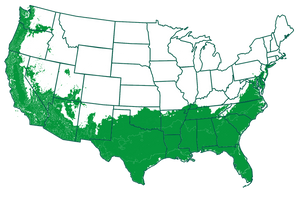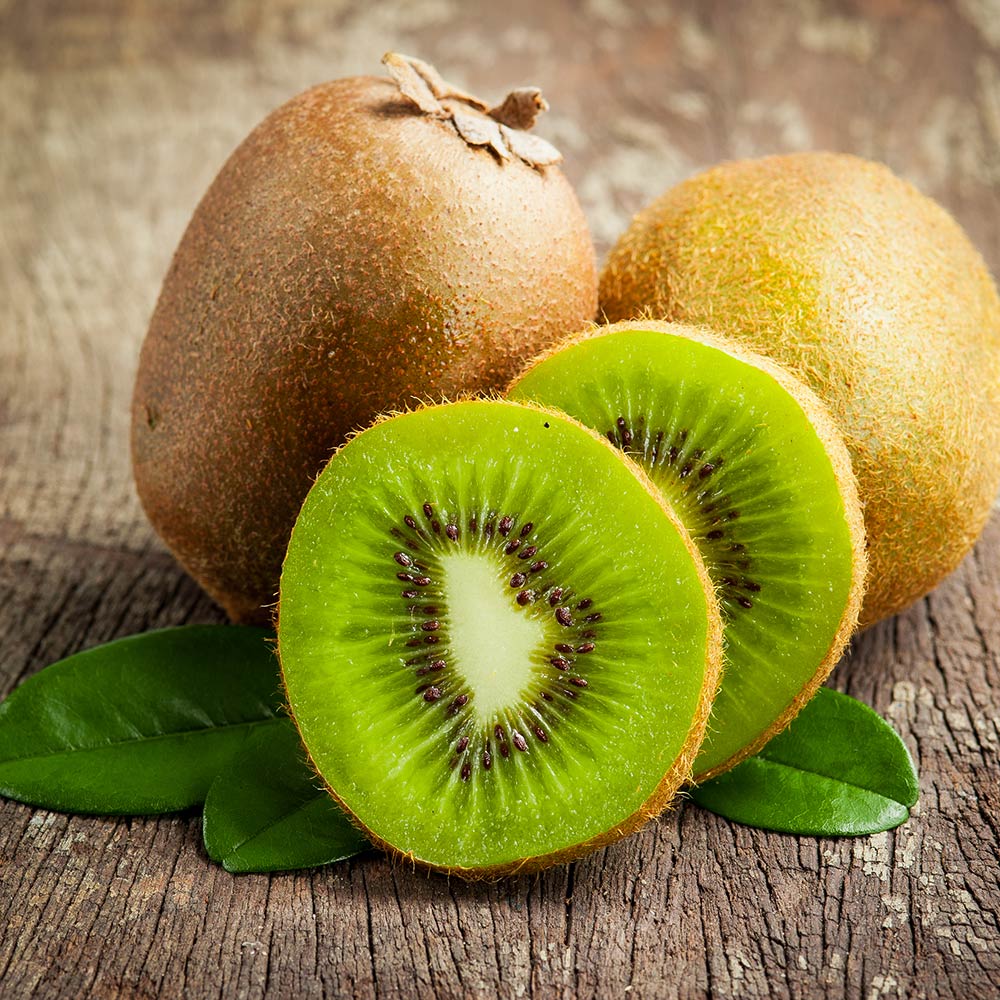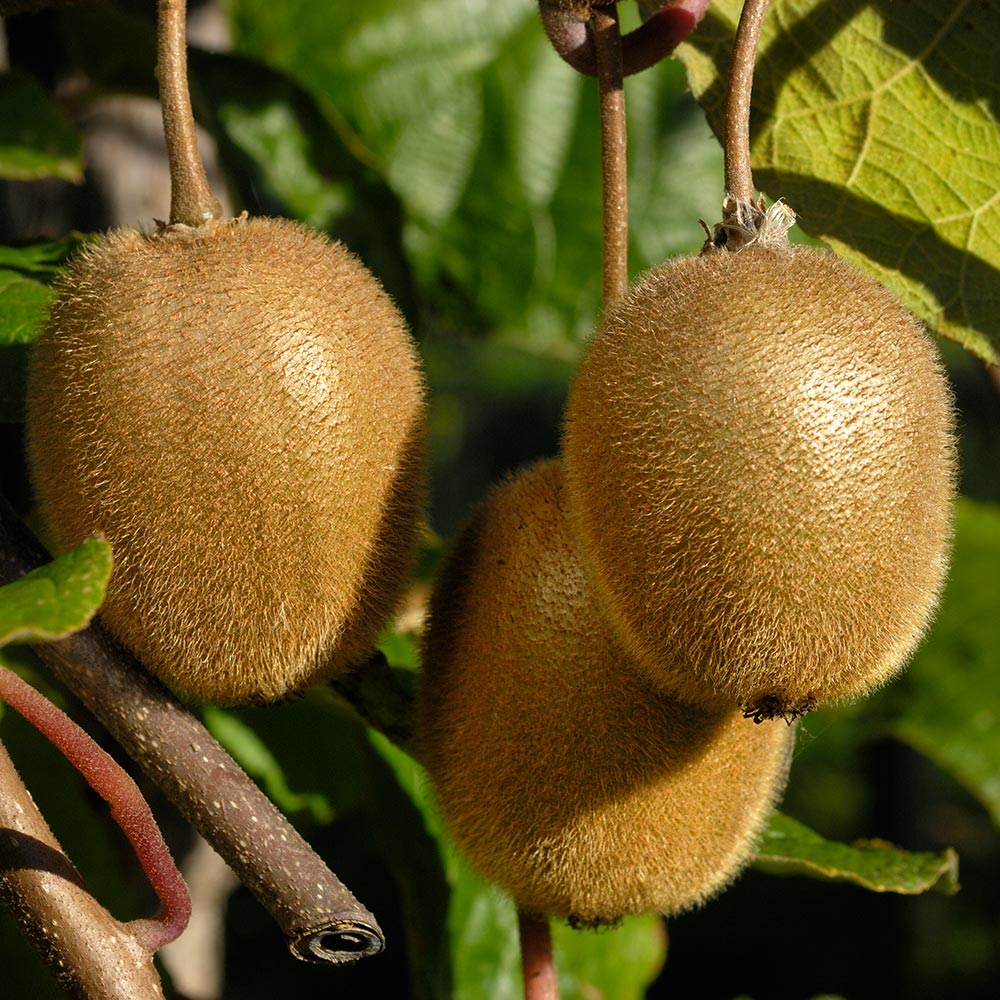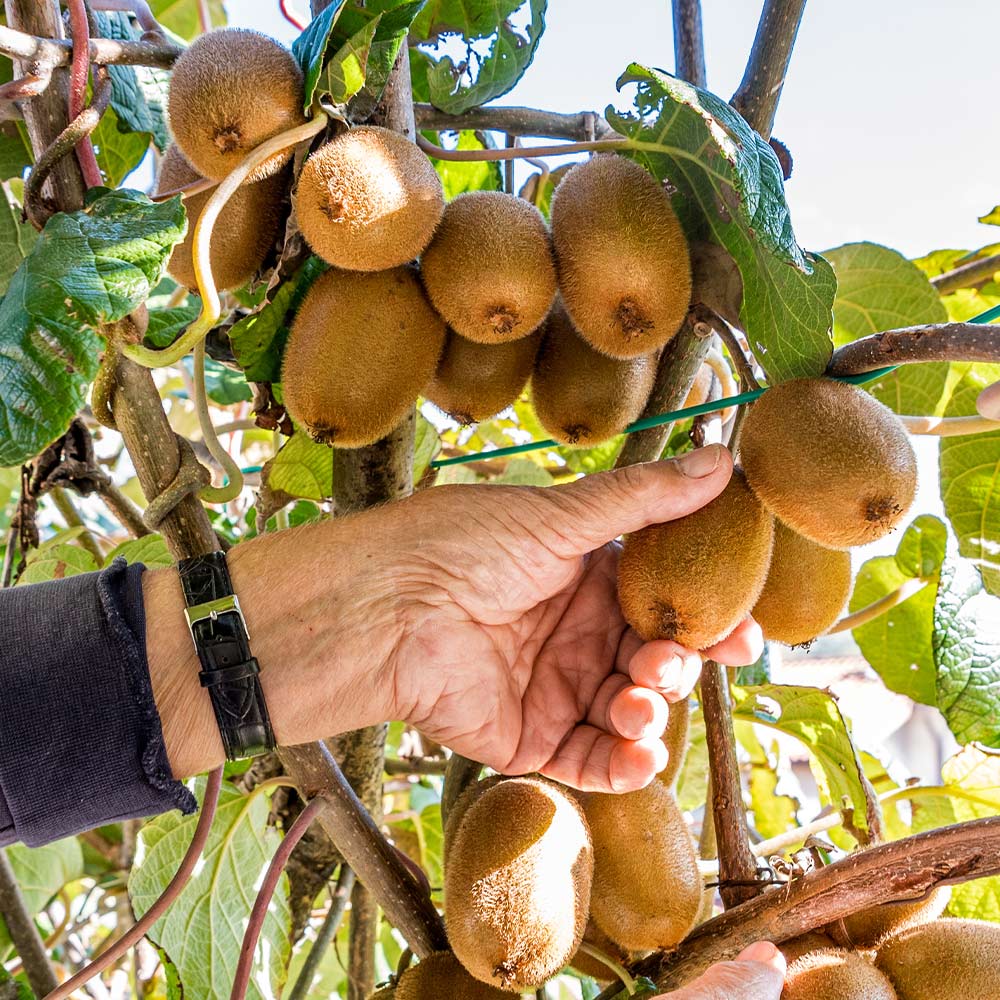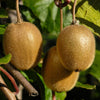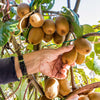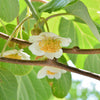* Images shown are of mature plants

Have questions? Talk with our Plant Experts (800) 973-8959
Save 25% on $200+ with code FALL25.
Questions? Call our plant experts: (800) 973-8959
Vibrant Green Flesh, Full of Tropical Flavors
Fuzzy Kiwis are an extremely popular fuzzy kiwi variety, celebrated for their rich tropical flavors. Once you pick your fresh homegrown kiwis and peel the brown fuzzy skin to reveal the bright, vibrant green skin you will be hooked.
Kiwi flesh is soft and rewarding to bite into because it’s filled with sweet, tropical juice that tastes like a sweet orange, pineapple, and strawberry all combined into one irresistible fruit. Tiny black seeds in the flesh provide a delectable crunch that leaves people wanting more and more.
By eating Fuzzy Kiwis, you will be boosting your health and snacking at the same time, because kiwis have tons of health benefits, like having 10 times the vitamin C as lemons, and tons of antioxidants.
Don’t rush to the store to buy over priced fruit, because Fuzzy kiwi vines are considered to be the easiest kiwi varieties to grow. When you purchase both a male and female plant for pollination, you will have large kiwi harvests providing all of the kiwis you’ve ever wanted, plus more.
The Hayward Kiwi’s fragrant white flowers will delight you in the early summer around May, before growing into delicious kiwis that will be ready to be harvested in the early fall around August.
If planted in the ground Hayward Kiwi vines can spread along fences and fill in the gaps with lush foliage, creating a living privacy screen. However, kiwi vines also grow extremely well in containers and are easy to keep small and maintain, indoors and out.
If you live above growing zone 7 simply bring your kiwi vines indoors once the weather starts to get cold, and place it by a sunny window. With a little water they’ll thrive.
Hayward Kiwi Vines are one of the most popular kiwi varieties in the country, so they sell out fast. Be sure to order yours today, before they are all gone.
Pollination Info
2-in-1 Fuzzy Kiwi Vine Pollination
Kiwi vines are not self-pollinating and need both a male and a female plant to make their delicious fruits. The Fuzzy Kiwi comes with both a male and a female plant in the same pot, making it easy to produce abundant fruit for years to come!
Planting & Care
Fuzzy kiwi plants (Actinidia deliciosa 'Hayward') are one of the easiest to grow, and most hardy varieties available. These fast growing plants produce gorgeous flowers and succulent fruit. The male and female plants cross pollinate and produce fruit that is packed with vitamins and antioxidants. These plants are recommended for USDA growing zones 7-10 and perform best in full and partial sunlight.
Location: Place your plants in an area with well draining soil, that preferably gets morning sun and afternoon shade. Though kiwi plants prefer full to partial sun, young plants cannot tolerate scorching heat. Keep this in mind when choosing your location. In order to get fruit, you will need to plant both a female and male for cross pollination. Male and female flowers are grown on separate plants. Male plants will flower often but will not produce fruit.
Planting Instructions: Place them in a sunny location with well draining soil. One male plant can pollinate up to 8 female plants, but you will need one female for each male plant you have.
Please Note: These plants share the same pot while they’re growing in our nursery. While this is ok when the plants are young, we highly suggest separating them when they arrive to your home. To do this, simply separate the roots with your fingers, using the trunks to guide you, before planting them. This will ensure they get properly established in their new home.
1) Dig your hole three times as wide and just as deep as the root ball on the kiwi.
2) Carefully separate the roots of your kiwi by gently combing the root ball with your hands and position them downward in the hole.
3) Backfill the planting area and tamp down lightly on the soil as you go to avoid any air pockets from forming.
4) Mulching the area will help conserve moisture in the soil and keep competing growth at bay.
Note: This product grows best in well-draining soil. When you receive your plant, you may notice small, white beads or rocks in the soil - this medium is added to increase drainage and keep your plant happy and healthy!
Watering: Kiwi plants need watered deeply and regularly the first year they are planted. This is most important during periods of drought. Never allow the soil to completely dry out. Browning and dropping of the leaves is a good indication of the plant not receiving enough water. Adding mulch around the plant will help it retain moisture. The best type of mulch to use for kiwi plants is straw or manure.
Fertilization: Kiwi plants are hungry plants and require heavy nitrogen to thrive; especially during the growing season. Ideal fertilization times are in early March and then again in early summer. You can also fertilize in the fall. However; late year fertilization can enhance the fruit size but hasten the ripening process, which later can cause the fruit to store poorly.
Pruning: You should definitely prune your Fuzzy Kiwi annually. This helps increase fruit production. Pruning should mainly be done to encourage growth, shape the plant and allow air and sunlight penetration.
Female plants: You can remove any shoots that are less fruit producing. Since Kiwis are typically grown on a trellis, once the vine reaches the very top of the trellis prune it back some to help train the vine.
Leave room for two buds near the top of the plant to grow. You can tie them loosely with planter’s tape to help support them, but allow them the room to grow. As the plant ages, continue to prune lateral shoots and allow the trunk to grow.
Male plants: Prune the flowering shoots down after the plant blooms. This can be done anywhere between 40-60 cm in length depending on the size of the plant. Ensure when you do this that mostly green growth is remaining on the shoots.
Pests: The wonderful thing about growing kiwi plants is they are virtually free of pest and fungal issues. Your plant may begin giving off a scent similar to “Cat Nip” as a result, cats find this plant attractive and will rub against the shoots. This can be problematic for young shoots and could cause damage. This is also makes the plant attractive to deer and gophers eating the leaves of the plant and in some cases the fruit. You can place protective fencing or netting around the plants as a protective measure.
If you have several plants growing in the same area this will also make them a target of scale and garden snails. They like to feed on the foliage. You can use an insecticidal soap or Neem Oil to treat any insect issues.
Shipping Details
Estimated Shipping Time: Most orders ship immediately. As noted on the website, some items are seasonal, and may only ship in spring or fall. Once your order is shipped, you'll receive an email with a tracking number.
| Amount of Order | Shipping Charge |
|---|---|
| Less than $49 | $19.95 |
| $49 + | FREE SHIPPING! |
Product Details
| Mature Height: | 20-30 ft. |
| Mature Width: | 20-30 ft. |
| Sunlight: | Full-Partial |
| Growth Rate: | Fast Growing |
| Harvest Time: | August |
| Botanical Name: | Actinidia deliciosa' Vincent' and 'Tomuri' |
| Does Not Ship To: | AK, AZ, HI |
| Grows Well In Zones: | 7-10 outdoors |
| Your Growing Zone: | # |
